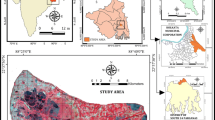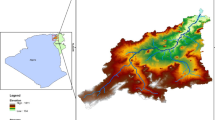Abstract
Land use and land cover are important biophysical factors which have a major role in different terrestrial processes on the earth. Land use and land cover change are a vital element of global environmental change. It is very essential for regional development and land use management towards sustainable development. The different time’s period satellite images in the study area have been studied to understand temporal as well as the spatial variability of land use and land cover (LULC) change. In this, an attempt was made to adopt the Markov model for obtaining and investigating the dynamics of land use change. Markov model was used as a stochastic model to make quantitative comparisons of the land-use changes between time periods extending from 2001 to 2010. Model performance was evaluated between the empirical LULC map obtained extracted from Landsat 8 (2017) image and the simulated LULC map obtained from the Markov model. The future land use distribution in the year 2019 and 2028 was acquired using a Markov model. This result shows that the Markov model and geospatial technology together are able to effectively capture the spatiotemporal trend in the landscape pattern in this study area.








Similar content being viewed by others
References
Riebsame, W. E., Meyer, W. B., & Turner, B. L., II. (1994). Modeling land-use and cover as part of global environmental change. Climate Change, 28, 45–46.
Cheruto, M. C., Kauti, M. K., Kisangau, P. D., & Kariuki, P. (2016). Assessment of land use and land cover change using GIS and remote sensing techniques: A case study of Makueni County, Kenya. Journal of Remote Sensing and GIS, 5, 175. https://doi.org/10.4175/2469-4134.1000175.
Ayivor, J. S., & Gordon, C. (2012). Impact of land use on river systems in Ghana. West African Journal of Applied Ecology, 20(3), 83–95.
William, F., Lora, R., Kenneth, D. A., Timothy, B. M., Timothy, G. R., Smith, J. L. R., & Christian, G. R. (2001). Land use change and effects on water quality and ecosystem health in the Lake Tahoe Basin, Nevada, and California. USGS Science for a Changing World, 01-29.
Gregory, K. J. (1995). Human activity and palaeohydrology (pp. 151–172). Chichester: Wiley.
Knighton, D. (1998). Fluvial forms & processes. Hodder Education, 01-384.
Yin, D., Chen, X., Yan, L., & Huang, Z. (2007). The research and realization of the land-use change forecasting model in development zones based on RS and GIS. In IEEE Proceedings IGARSS (pp. 3429–3432).
Sylla, L., Xiong, D., Zhang, H. Y., & Bangoura, S. T. (2012). A GIS technology and method to assess environmental problems from land use/cover changes: Conakry, Coyah, and Dubreka region case study. The Egyptian Journal of Remote Sensing and Space Sciences, 15, 31–38.
Kumar, S., Radhakrishnan, N., & Mathew, S. (2014). Land use change modeling using a Markov model and remote sensing. Geomatics, Natural Hazards and Risk, 5(2), 145–156. https://doi.org/10.1080/19475705.2013.795502.
Zhang, K., Yu, Z., Li, Y., Zhou, W., & Zhang, D. (2007). Land use change and land degradation in China from 1991 to 2001. Land Degradation and Development, 18(2), 209–219.
Liu, J., Kuang, W., & Zhang, Z. (2014). Spatiotemporal characteristics, patterns, and causes of land use changes in China since the late 1980s. Journal of Geographical Sciences, 24(2), 195–210. https://doi.org/10.1007/s11442-014-1082-6.
Li, Y., Liu, G., & Huang, C. (2017). Dynamic changes analysis and hotspots detection of land use in the central core functional area of Jing-Jin-Ji from 2000 to 2015 based on remote sensing data. Mathematical Problems in Engineering. https://doi.org/10.1155/2017/2183585.
Eirinaki, M., Vazirgiannis, M., & Kapogiannis, D. (2005). Web path recommendations based on page ranking and Markov models. In WIDM (pp. 2–9).
Khawaldah, H. A. (2016). A prediction of future land use/land cover in Amman area using GIS-based Markov model and remote sensing. Journal of Geographic Information System, 8, 412–427. https://doi.org/10.4236/jgis.2016.83035.
Kumar, N. K., Sawant, N. G., & Kumar, S. (2011). Forecasting urban growth based on GIS, RS and SLEUTH model in Pune metropolitan area. International Journal of Geomatics and Geosciences, 2(2), 568–579.
Muller, R., & Middleton, J. (1994). A Markov model of land-use change dynamics in the Niagara Region, Ontario, Canada. Landscape Ecology, 9(2), 151–157.
Majumder, D. (1978). West Bengal District Gazetteers, Nadia. Government of West Bengal, 5–16.
Biswas, K. R. (2001). Rivers of Bengal (Vol. I). Government of West Bengal (pp. xviii, xxix, 87, plate-18 and 19).
Bagchi, K. (1978). Diagnostic survey of deltaic West Bengal, a research and development project. Department of Geography, Calcutta University, 17.
Bandyopadhyay, S., Ghosh, K., Saha, S., Chakravorti, S., & De, S. K. (2013). Status and impact of brickfields on the river Haora, West Tripura. Transactions, 35(2), 275–286.
District Census Hand Book, Nadia (2001). Directorate of Census Operations, West Bengal.
Reis, S. (2008). Analyzing land use/land cover changes using remote sensing and GIS in Rize, North-East Turkey. Sensors, 8, 6188–6202.
Samal, D. R., & Gedam, S. S. (2015). Monitoring land use changes associated with urbanization: An object-based image analysis approach. European Journal of Remote Sensing, 48, 85–99. https://doi.org/10.5721/EuJRS20154806.
Gergel, S. E., & Turner, M. G. (2003). Learning landscape ecology (pp. 35–48). Berlin: Springer.
Sundarakumar, K., Harika, M., Begum, A., Yaini, S., & Balakrishna, K. (2012). Land use and land cover change detection and urban sprawl analysis of Vijayawada city using multitemporal landsat data. International Journal of Engineering Science and Technology, 4, 170–178.
District Census Hand Book, Nadia. (2011). Directorate of Census Operations, West Bengal.
District Census Hand Book, Barddhaman. (2011). Directorate of Census Operations, West Bengal.
Acknowledgements
The authors like to acknowledge USGS for providing data for the study and also like to thank the Department of Geography, Adamas University for providing necessary facility to conduct the study. We also like to thank anonymous reviewers and the editor for their comments and suggestions for improving the manuscript.
Author information
Authors and Affiliations
Corresponding author
Ethics declarations
Conflict of interest
On behalf of all authors, the corresponding author states that there is no conflict of interest.
Additional information
Publisher's Note
Springer Nature remains neutral with regard to jurisdictional claims in published maps and institutional affiliations.
Rights and permissions
About this article
Cite this article
Das, S., Sarkar, R. Predicting the land use and land cover change using Markov model: A catchment level analysis of the Bhagirathi-Hugli River. Spat. Inf. Res. 27, 439–452 (2019). https://doi.org/10.1007/s41324-019-00251-7
Received:
Revised:
Accepted:
Published:
Issue Date:
DOI: https://doi.org/10.1007/s41324-019-00251-7




